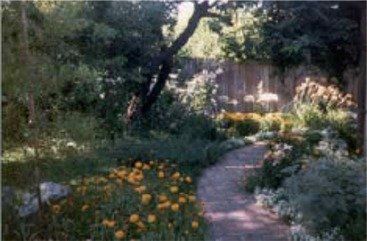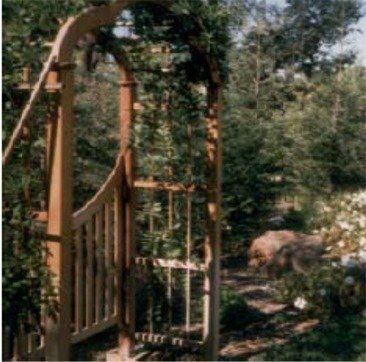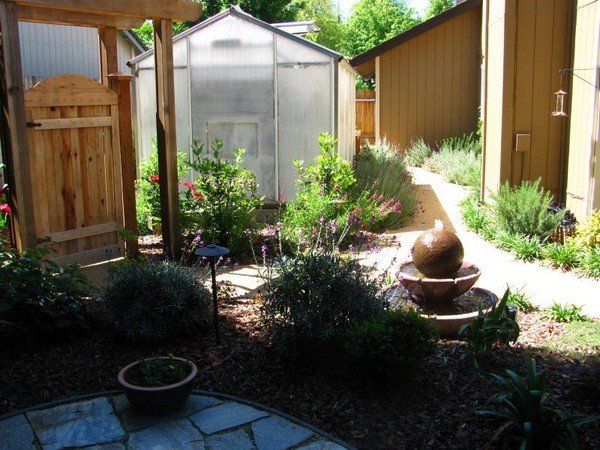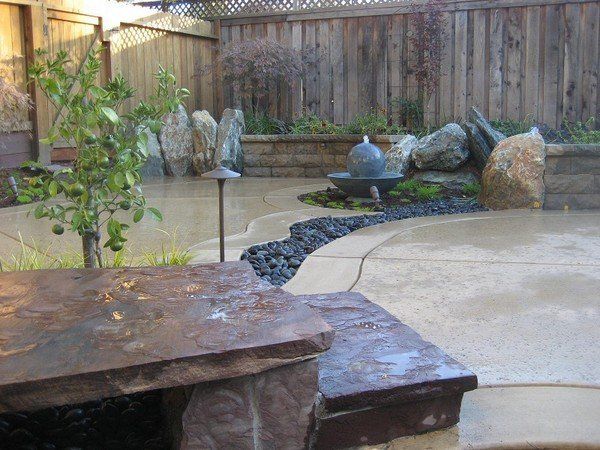Backyard Privacy
Landscape design can meet many backyard desires
Homeowner wants to add privacy and beautify her yard
The Sacramento Bee, Home Remodeling Q&A, March 6, 2008
Q: I live in a small cottage home in a nice location, but my “blah” backyard has too much lawn and not enough privacy from my neighbors. I like my neighbors, but don’t feel like saying “hello” every morning when I am in the yard with my coffee. Could you suggest some creative ways to remodel my backyard? -- Rachel Williams, Sacramento

Cozy shaded cottage garden
A: Many homeowners yearnfor a private park in their own backyard for relaxing as well as a practical yard to meet their family’s needs for entertaining and play, says Susan Silva, owner of Susan Silva Landscape Design in Orangevale.
There’s a multitude of things to consider before putting a shovel into the ground, so it is always best to start with a plan designed to cover the overall picture, even if you have to implement it in stages.
“Privacy can be easily addressed with trees and tall shrubs, but it’s vital to consider the size of the yard,” Silva says. “In smaller yards, I like to mix varieties of tall, linear shrubs along the fence line and add canopy-type trees so you can see underneath them to other areas of the yard and enjoy the shade they create for the patio area.
“In larger backyards, the choices of big trees and shrubs are endless, but they need to be properly planted in the right locations, always considering
their growth at maturity.”
When remodeling a yard, Silva says, she looks carefully at the existing trees, shrubs and other features in hopes of keeping as many of the original elements as possible while creating something new and beautiful.
Many mature plants are worth saving; old patios can often be updated by contractors when saw-cutting the edges into new shapes and overlaying new materials onto the old gray concrete.
“I assume by ‘blah’ you mean boring, with little interest, color, or movement, and in need of a focal point,” she says. “That’s why I always try to create a feeling of intrigue, fun and mystery into every yard, big or small, to make it
truly special.”
One inexpensive and simple idea is to create a curvy planted path from one area to a decorative gate and arbor. Curved paths can be made with ground cover or even a meandering piece of lawn. The gate can match the style of the home or be an eclectic, artistic, colorful one-of-a-kind feature that can be built by a contractor or purchased.

An arbor and gate planted with fragrant roses and clematis
creates a feeling of mystery and illusion of much more space behind it.
“Whether it leads to a rose garden, a serene fountain and bench, a vegetable and herb garden or even just disguises a storage area, a gate creates a
feeling of mystery and the illusion of much more space beyond it,” Silva says.
Although the Wells and Schimandle home's half-acre lot backs up to Clover Valley Creek, a fence and a steep hill covered with blackberry brambles blocked their view of the creek. Many old, overgrown, diseased shrubs camouflaged the majestic oak trees and classic koi pond in their existing backyard.
The remodeling project will consist of tearing out the 40-year old shrubbery and planting colorful privacy shrubs and flowers. Covering a metal-screen fence with climbing vines will hide a storage shed, while removing the fence and terracing the hill leading down to the creek will open up the yard so it looks and feels larger.
“The highlight of the yard will be a new quiet place perched over the creek for meditation and yoga,” says Silva. “A planted pathway will meander from here to the flowering gate and arbor connecting the backyard to the side and front yards, which Silva redesigned for the couple several years ago. Wells says they could only afford to install new landscaping in the front half of their lot the first time they hired Silva. They love the results so much, they know it was worth waiting to do the back.
“If you could see my front yard you would know it was the work of a true artist,. “When you drive down my street, you see many yards that
look nice but very structured with all the standard stuff, while ours has a special touch that catches your eye. People who walk by constantly tell us our yard is so beautiful.”
Shade from all the trees in their side yard kept grass from growing there, so they did nothing with that area until Silva turned it into a beautiful garden of ferns, hydrangeas and other shade-loving plants with a curvy groundcover path in the middle.
“From the street, you will be able to see past the intriguing gate, inviting you into the backyard,” she says. “It will be beautiful walking under the
trees and feel quiet and peaceful, like you’re in a little piece of the country. It will be magical, I know.”



